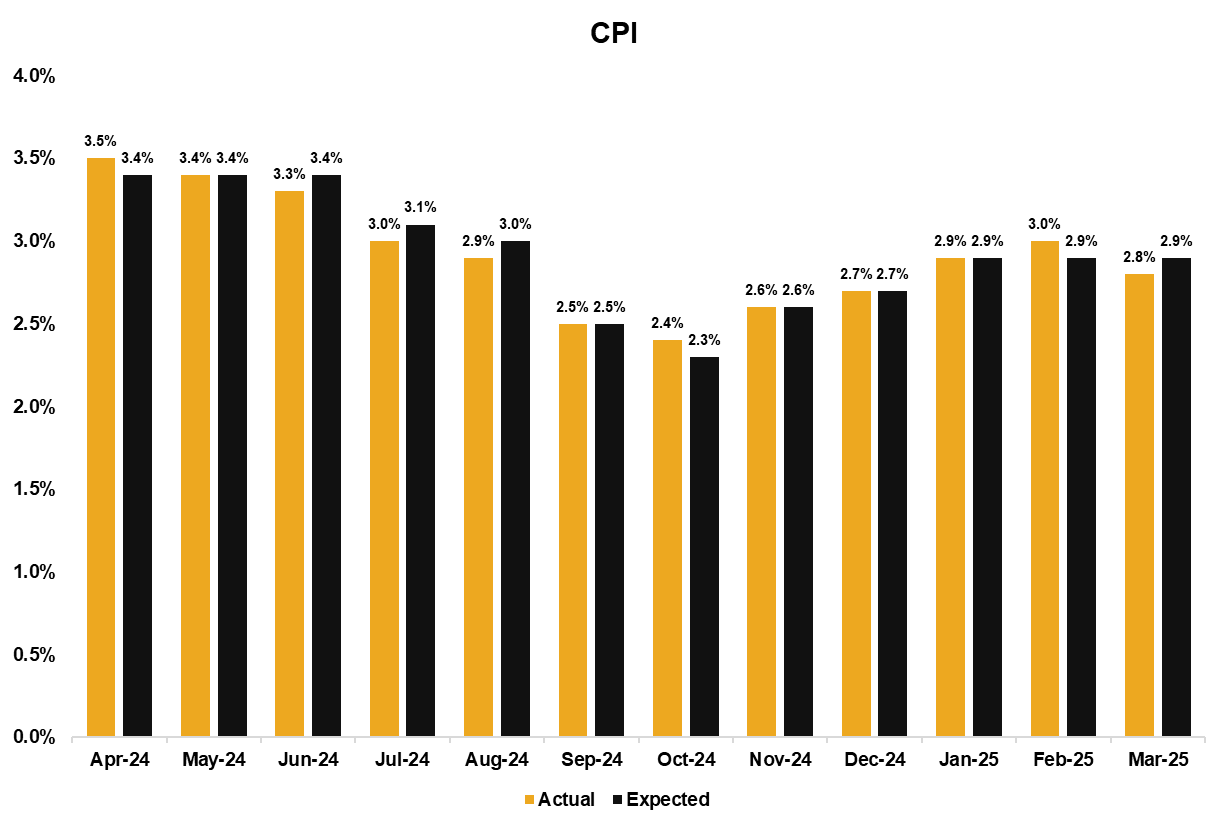
Financial markets have been gripped by intense volatility as President Trump’s aggressive tariff policies ignite widespread turmoil and stoke growing fears of an impending recession. The S&P 500, which had climbed to a peak of $6,147 during the so-called Trump-Pump rally, erased all these gains, retreating to October 2024's pre-election levels. The index tumbled nearly 10% to a low of $5,528 before staging a modest rebound to close at $5,572 on March 11. Given the magnitude of the decline, it’s possible that markets have fully priced in recession risks, reflecting the worst-case scenario of prolonged trade disruptions and an economic slowdown. As seen in figure 1, the sell-off rippled across other major indices, with the tech-heavy Nasdaq plunging almost 13% from its recent highs, reflecting heightened investor anxiety over trade disruptions and economic slowdown. Meanwhile, the Dow Jones Industrial Average shed roughly 8%, underscoring the broad-based unease gripping Wall Street as uncertainty over global trade and corporate earnings mounts.
Figure 1: 1-Year Performance of Major Indices vs Bitcoin

Source: 21Shares, Tradingview
Data as of 3/12/2025
The turbulence wasn’t confined to the traditional markets, the crypto markets also took a hit. Bitcoin, which had soared to nearly $109,000 on the day of President Trump’s inauguration, stumbled dramatically, plummeting to a post-election low of $76,500—a level not seen since the presidential election on November 5, 2024. Flagship crypto wasn’t alone in its descent; Ethereum and Solana followed suit, swept up in the broader market unease. Ethereum cratered to the $1,700s, a 2.5 year low and a price last witnessed in November 2022, while Solana rolled back to levels not touched since the Japanese Yen Carry Trade unwound in August 2024—a chaotic period when Bitcoin briefly wicked down to $48,500. The synchronized sell-off across these digital assets highlighted their growing correlation with macroeconomic jitters, from tariff-induced trade fears to shifting investor sentiment in a high-stakes economic climate.
Crypto Fear and Greed Index
This fear-driven capitulation is reflected in the Crypto Fear and Greed Index, a sentiment gauge that ranges from 0 (extreme fear) to 100 (extreme greed), using factors like volatility, momentum, and social sentiment to quantify market emotions. Two weeks ago, the index plunged to a low not seen since the Terra Luna collapse, an event that erased $100 billion in market capitalization practically overnight. While the index typically hovers around 45-47, a sign of neutral sentiment, it now sits at 24, underscoring the heightened investor anxiety gripping the market.
Please see the Fear and Greed levels below:
- 0-24, Extreme Fear: Indicates significant investor panic and potential buying opportunities.
- 25-49, Fear: Cautious sentiment, often signaling market uncertainty.
- 50-74, Greed: Investors are becoming overly optimistic, leading to potential overbought conditions.
- 75-100, Extreme Greed: Market euphoria, often preceding corrections or downturns.
Figure 2: Crypto Fear and Greed Index vs BTC

Source: 21Shares, Coinglass
Data as of 3/12/2025
Trump’s Strategic Bitcoin Reserve Executive Order and Digital Asset Summit Fallout
While macroeconomic headwinds set the stage for this widespread market downturn, the lackluster outcome of President Trump’s highly anticipated Digital Asset Summit on March 7, 2025, only exacerbated the sell-off in crypto. Touted as a pivotal moment for U.S. crypto policy, the summit came on the heels of Trump’s Executive Order establishing a Strategic Bitcoin Reserve and a U.S. Digital Asset Stockpile. Let’s take a closer look at these initiatives:
- Strategic Bitcoin Reserve: Established under Trump’s Executive Order, this reserve consolidates all Bitcoin (BTC) held by the U.S. government—approximately 200,000 BTC, primarily seized through criminal and civil forfeiture proceedings—into custodial accounts managed by the Treasury. Valued at roughly $17 billion as of March 2025, this fixed supply is designated as a national reserve asset, akin to ‘digital gold,’ to be held indefinitely without sales unless specific legal exemptions apply (e.g., returning assets to crime victims). The order tasks the Treasury with exploring budget-neutral strategies to acquire more BTC, positioning the U.S. as a pioneer in leveraging Bitcoin’s scarcity for strategic economic advantage.
- U.S. Digital Asset Stockpile: Separate from the Bitcoin Reserve, this program serves as a secure repository for all non-Bitcoin digital assets (e.g., Ethereum, Solana, XRP) forfeited to the government via criminal or civil actions. Managed by the Treasury, the stockpile empowers the Secretary of the Treasury to actively oversee and manage these assets as deemed appropriate, determining strategies for responsible stewardship in accordance with applicable law. While no additional assets can be acquired beyond seizures without further executive or legislative approval, this differs from the Bitcoin Reserve’s strategic focus by granting the Treasury discretionary authority to adapt its management approach rather than merely holding the assets passively.
Yet, at the summit, Trump delivered little more than a rehash of these already-publicized plans, leaving investors deflated. Many had hoped for bold new revelations - perhaps specifics on the budget-neutral strategy to amass more Bitcoin or tax incentives for crypto holders - but instead they were met with a reiteration of the status quo. The disappointment sent crypto markets on a wild ride. As seen in figure 3, Bitcoin briefly surged to $91,000 as lingering optimism sparked a rally, only to plunge back to $84,000 by day’s end as the ‘nothing burger’ reality set in. This volatility further rattled markets already on edge from tariff-driven turmoil, exposing the fragile confidence underpinning an increasingly uncertain economic landscape.
Figure 3: BTC & ETH Price Day of Digital Asset Summit

Source: 21Shares, Tradingview
CPI (Consumer Price Index)
Amid the storm of tariff-driven volatility, February’s CPI data provided a much-needed reprieve. The latest inflation print undershot expectations, fueling a sharp rally across risk assets and reigniting hopes of an earlier Federal Reserve rate cut. January’s headline CPI came in at 2.8% year-over-year, with core CPI at 3.1%, both softer than consensus forecasts of 2.9% and 3.2%, respectively. This unexpected cooling in inflation sent markets soaring—the S&P 500 futures surged from the low $5600s to the mid-$5600s, with the index opening higher on the day. Bitcoin, which had been battered by macroeconomic headwinds, briefly retested $85,000 as rate cut speculation intensified.
Figure 4: CPI - Actual vs Expected

Source: 21Shares, U.S. Bureau of Labor Statistics
Drivers of CPI
A deeper dive into the CPI components sheds light on what’s driving inflation beneath the surface. Shelter costs rose by 0.3%, accounting for nearly half of the monthly increase in the all-items Consumer Price Index (CPI), underscoring its role as a persistent inflationary force. The energy index edged up 0.2% despite a 1.0% decline in gasoline prices, buoyed by rising electricity and natural gas costs, though energy prices remain down 0.2% year-over-year. Food prices also ticked up 0.2%, with food away from home climbing 0.4% while food at home remained unchanged, contributing to a 2.6% annual rise in the food index. Other notable price hikes occurred in medical care, used cars and trucks, household furnishings, recreation, apparel, and personal care—though airline fares and new vehicle prices declined, offering some relief to consumers.
Market’s Outlook on Rate Cuts
Against this backdrop, rate cut expectations have surged. The CME FedWatch Tool now reflects a dramatic shift in sentiment:
- The probability of a May rate cut has more than tripled month-over-month, jumping from 10.1% to 31.4%.
- Expectations for three cuts by year-end have skyrocketed over fivefold, surging from 6.3% to 32.5%.
- Notably, the odds of four cuts by year-end have exploded 21 times over, from a mere 1% to 21%.
This data underscores the market’s increasingly dovish outlook on Fed policy, suggesting that investors anticipate a more accommodative stance in response to mounting economic turbulence.
With recession risks potentially fully priced in after the S&P’s sharp decline and crypto’s brutal sell-off, today’s CPI data hints at a possible inflection point. If rate cuts materialize, a wave of liquidity could reignite bullish momentum, pushing equities and Bitcoin past key resistance levels. BTC, which has been grappling with macro-driven volatility, could surge beyond $90,000—bringing the elusive $100,000 milestone within reach. Such a rally would offer a much-needed lifeline to markets reeling from trade fears and policy uncertainty, restoring confidence in risk assets after weeks of turbulence.


.svg)



_logo.svg)

.svg.png)